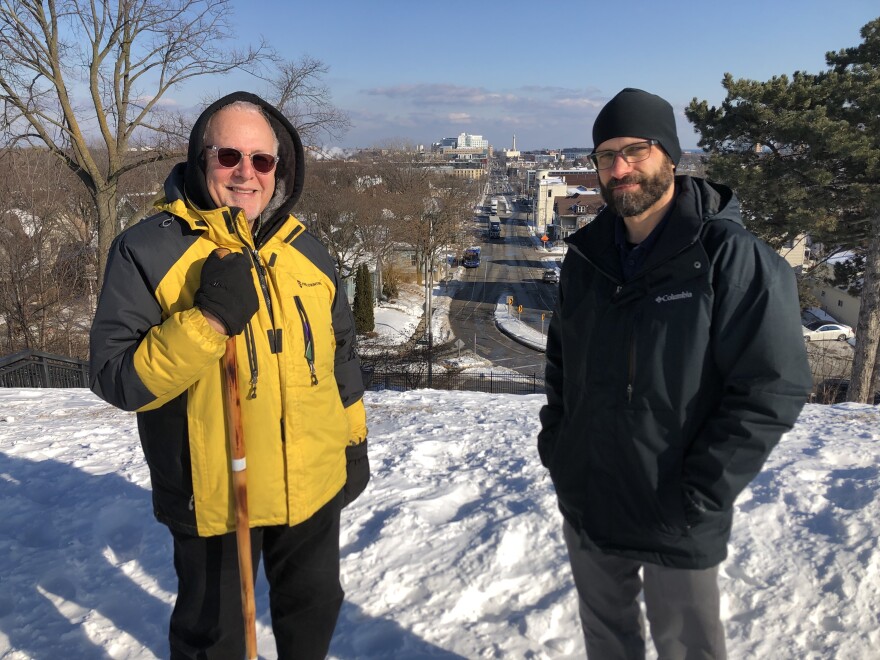If you follow North Avenue east toward the lake, the road curves around a big hill. Last summer, Milwaukeean Mark Behar decided to walk to the top.
"I hiked up the park and was immediately impressed with the incredible views of the entire city," Behar says.
That visit to Reservoir Park made Behar wonder about its history. He submitted this Bubbler Talk question: "What's the significance of the reservoir? What happened to it?"

Kilbourn Reservoir Park is named after former Mayor Byron Kilbourn, who deeded the land to the city. In the deed, he specified that the land be used for a public park.
In the 1870s, Milwaukee began building its first water utility system. A 25-foot-deep reservoir was constructed at the top of the park.
"Kilbourn Reservoir was one of the first three original structures of the Milwaukee Water Works," says Milwaukee Water Works marketing officer Brian Rothgery.
The other two original structures are the North Point Pumping Station across from Bradford Beach and the gothic-looking North Point Water Tower. The system distributed Lake Michigan water through about 50 miles of pipes serving Milwaukeeans.
"Water was brought into the North Point Pumping Station from an intake in the lake, and from there it was pumped up the hill, past the water tower at the top of the hill, up North Avenue, through water mains, and it would fill up the reservoir," says Rothgery. "From the reservoir it would flow into the distribution by gravity."

Gravity naturally created water pressure, which is why the reservoir was built on the highest hill in Milwaukee.
Ben Barbera, director of collections at the Milwaukee County Historical Society, says one of the first things the water was used for was to brew beer. No surprise there.
"The very first customer was the Phillip Best Brewing Company, which is the predecessor to Pabst Brewing Company," Barbera explains.

For about 40 years, Milwaukee customers drank the Lake Michigan water untreated.
"Beginning in 1913, they started adding chlorine to the water to eliminate some of the waterborne diseases," Barbera says. "That took care of the disease, but the water itself was cloudy, had an odor and a flavor to it. Occasionally fish would make their way through the system and into people’s houses."
A 1939 Milwaukee newspaper headline reads: “City’s Sorry if You Find Fish in Water Glasses.” Apparently, a school of perch were living in the Kilbourn Reservoir, and their progeny got sucked into the distribution pipes.

The 21-million gallon reservoir was open to the elements until 1979, when it was covered with a concrete cap.
Why was it covered? Mark Behar, the Bubbler Talk question-asker, remembers hearing something about LSD.
"There was a conspiracy at the time that thought that leftists and hippies were going to poison everyone’s water so everyone would have a good LSD trip," Behar says.
Barbera and I searched newspaper archives, but we couldn’t find anything about an LSD panic.

The main concern may have been more mundane: one 1978 article says environmental agencies were worried about the reservoir’s exposure to air pollution.
"There’s lots of potential reasons for capping the reservoir," Barbera says. "Most likely it was to keep foreign matter out of the drinking water."
By the later 20th century, Milwaukee had many other water intake and storage facilities. Kilbourn Reservoir was kept in use as a backup for peaks in demand. But by 2004, it became redundant and was decommissioned to save money.
The city filled the reservoir with 88,000 cubic yards of soil and landscaped it with grass and trees.

Brian Rothgery, with Milwaukee Water Works, has lived near the park for 17 years.
"I walk here all the time," Rothgery says. "I come here and sit on the bench and look out at the city. And there’s really no other place like it. Milwaukee has a number of amazing parks, but there’s no other park that has a view like this one."
The elevation of the park, which made it an ideal reservoir location in 1874, gives it one of the best views in the city today.
_















